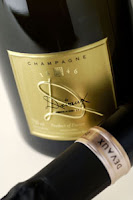Prestige is part of it. Production limits and intensive labor are the real reasons.
Most Champagne – true Champagne from France – is not cheap.
Yield is capped at 2600 liters per 4000 kg. That’s 2050 liters of noble free-fun. And 550 pressed juice. Additionally. All grapes must be picked by hand. Adding to processing costs.
The four main regions are situated just outside Paris – the northernmost area of grape growth. Covering 34,000 hectares. Consisting mainly of chalk and limestone.
- Montagne de Reims
- Côte des Blancs
- Vallée de la Marne
- Aube Vineyards
 Most people are surprised to learn that 80% of champagne is made from red grapes. Limited bottles are produced blanc de blanc – white from white, 100% white grapes. Pinot-noir, pinot-meunier, and chardonnay are the only permitted varietals.
Most people are surprised to learn that 80% of champagne is made from red grapes. Limited bottles are produced blanc de blanc – white from white, 100% white grapes. Pinot-noir, pinot-meunier, and chardonnay are the only permitted varietals.The process begins like any other white or rosé wine. A still wine is made. Allowed to ferment – change sugar into alcohol – for one to two weeks. Sealed with nothing more than a beer cap. The top is then removed. More sugar added. Starting a second fermentation. This time, producing carbon dioxide, bubbles.
 Champagne is cellar-matured for two to tens years depending on the cuvée– blend, of different years. Labeled as such. Most sparkling wine is a mixture of different vintages. Making them NV – non-vintages.
Champagne is cellar-matured for two to tens years depending on the cuvée– blend, of different years. Labeled as such. Most sparkling wine is a mixture of different vintages. Making them NV – non-vintages. Our final French Wine class was unfortunately rushed due to our pesky exam that took up the first half. Nonetheless we managed to get our tastings in. Including a final vintage (1999) Devaux.
Our final French Wine class was unfortunately rushed due to our pesky exam that took up the first half. Nonetheless we managed to get our tastings in. Including a final vintage (1999) Devaux.Aged champagne is said to be foxy. Not because of its beauty. But because it smells of fox. And boy was that an accurate description. Almost repulsive. We tasted the wine. Divine! Smooth. Round. Calm, yet full of flavor. My favorite of the evening. Retailing for nearly 60 Euros, it’s not something I would ever buy myself. A nice adieu to this term’s wine class.
Next term’s Wines of the World should be more than interesting.
Lesson #6 – Tastes
- Champagne brut by Le Repaire de Bacchus, NV
- Champagne blanc de blanc by Melard, NV
- Champagne rosé brut by Haton, NV
- Champagne by Devaux, 1999
No comments:
Post a Comment